Xenotransplantation
Amidst the aftermath of COVID-19 waiting lists continue to grow for those in need of an organ transplant, whilst simultaneously in an American surgery a man recieves the heart of a pig. Animal donors may be the answer to our shortage of available organs, but the procedure isn't quite ready to become common place. Take a trip down memory lane and embark on the jounrey of transplantation, where it began, where we are right now and what the future might look like in the next decade. Plus, catch up on chimps applying insects to their wounds, the current uses of facial recognition and how tech can aid those suffering with spinal cord injuries...
In this episode
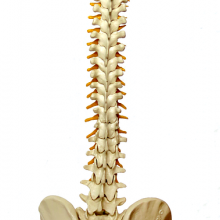
01:50 - Electronic implant aids spinal cord injuries
Electronic implant aids spinal cord injuries
Gregoire Courtine, Swiss Federal Institute of Technology Lausanne, Jocelyne Bloch, Lausanne University Hospital & David M'zee
Injuries to the spinal cord usually result in permanent disabilities, including paralysis. This is because the spinal cord is effectively a giant bundle of nerve pathways that connect the brain with the motorneurones that make muscles move. Cutting the cord disconnects the two, so signals to move can’t make it through. But now scientists in Switzerland have published results on a system they’ve developed to bypass the block. They use electrical implants in the spinal cord controlled by external computer systems to activate the motor nerves directly and restore movement. Julia Ravey spoke to Grégoire Courtine from the Swiss Federal Institute of Technology Lausanne whose team designed the technology, and neurosurgeon Jocelyne Bloch…
Grégoire - The spinal cord is disconnected from the brain. So it's anatomically intact, but it's in a silent state. We are inserting electrode arrays, which use electricity and re-awaken the spinal cord, in order to reestablish the motor function.
Julia - You've performed this procedure on several patients. What have been the results?
Jocelyne - We've implanted nine patients. The first six had an incomplete spinal cord injury, meaning that they still had a little bit of neurological function. And the last three had a complete spinal cord injury - this means that they had no movement, no sensations. All nine could immediately step after the surgical procedure, but they all needed a few months of training in order to be better and better.
Julia - Is there a line, do you think these individuals can get better and better with their motor function? Or do you think there's going to be a stop point of where they can improve?
Jocelyne - Surprisingly, the first patient we implanted with an incomplete spinal cord injury - that was in 2016 - and he was with that for six months and we still see him every six months, coming from some tests and examinations, and we still see progress. So as long as they keep training, even if it's a slow curve, they keep progressing. So it's hard for us to tell exactly where it's going to stop.
Julia - One of the recipients of these implants is David M'zee, who joins us now,. David, how has this procedure changed your life day to day?
David - I have an incomplete injury. So now that I have more strength in my right leg and a little bit of something in my left one, it makes it easier to get into my wheelchair when I'm on the floor. So if I go to the lake in summer to take a swim, when I get back, it's much easier to get back in my chair. So it's many things that have changed, but it's not like I'm walking at home in an everyday life setting.
Julia - How do you operate the implant itself?
David - The implant is controlled by a tablet. It's a little bit cumbersome because the tablet is connected to a device that communicates with another device that communicates with even another device that in the end communicates with the internal pulse generator. But in the end, once the connection is established, I can control the stimulation from the tablet. And then I can increase, for example, the amplitude of the signals down to the legs and I can play with timings and stuff. So once it's all set up it's a really cool thing.
Julia - So far, this technology's been used for people who still have a certain length of spinal cord intact. Is there any hope for people who have a different type of paralysis to benefit from this type of technology?
Grégoire - What we are conducting as a research trial is to link the brain to the stimulation. So electrodes in the brain decode the intention and link it wirelessly to the stimulation: a wireless bridge between the brain and the spinal cord.
Julia - And when do you think the technology that has been used in these clinical trial patients will be more widely available?
Jocelyne - It's still hard to say. There are still a few ongoing clinical trials, but I hope that within a few, let's say two to three years, there will be a product available.
Grégoire - To get the right expectation, our patients still live in a wheelchair. So they can stand, take a few steps, but it is not a cure for spinal cord injury. Our goal is to maximize recovery, improve quality of life, but this is not enough to cure spinal cord injury.
Julia - David, what would be the next step that you'd love to reach with your training?
David - The next really big step would be to walk hands free. But I think with only this technology, at least in my case, it would be really hard to achieve that. But other things were called impossible before, so we'll see how it goes.

06:43 - Where should facial recognition be used?
Where should facial recognition be used?
Gareth Mitchell, BBC & Stephanie Hare, Author & Lord Clement-Jones
When we think of our personal data, we often consider information like our phone number, bank details, or email address. But what about our eyes, ears, mouth, and nose? Facial recognition is increasingly being used to tag and track our individual activities, and while commonplace in unlocking personal devices like laptops and phones, certain institutions are keen to use our features for much more than mugshots. This includes the US Treasury, who last week backtracked on plans for mandatory facial verification for people logging their tax returns. So why are some people wary of firms having their faces on file? Robert Spencer finds out more...
Robert - It's a question that appears time and time again. How comfortable are we as a society with facial recognition? As unlocking your phone shows, in some respects the answer is clear, but when it comes to having your face scanned as you walk down the street, the issue becomes more murky.
Gareth - It's a biometric identifier. That means using aspects of your body for identification. The issue is that all of us are walking around in public showing our faces, meaning that anybody with a scanner, if they want to can mount a camera, and use an algorithm to identify us. We don't have any control over who is using our face as the identifier.
Robert - That's Gareth Mitchell who presents Digital Planet on the BBC world service. This lack of control and consent is key to one of the central paradoxes in the discussion around facial recognition. It speaks to the differences in technologies involved as Stephanie Hare explains in her new book, Technology Is Not Neutral: A Short Guide to Technology Ethics.
Stephanie - There are different types of facial recognition technology. So let's start with facial verification. That's the kind that you would use to unlock your own smartphone. That's not a very high risk use of facial recognition technology because the biometric never leaves your phone. A higher risk example is going to be when the police are using live facial recognition technology to identify people in a crowd. This might be high risk because it can have a chilling effect on free speech. If people fear that when they're going to these protests, they're being scanned by the police.
Robert - But it's not just about giving consent and having control of your biometrics. The algorithms themselves are large complex computer programs, often hidden behind company secrets. And it turns out, they aren't always as accurate as we'd like.
Stephanie - It doesn't work as well on people with darker skin. It works particularly poorly on women with darker skin, but it can also be a problem with children, with trans people and with elderly people.
Robert - The fix though might not be as simple as it seems.
Gareth - In order for the algorithms to get better at recognizing a whole diversity of faces, that would mean training those algorithms on more and more faces. And so opponents would say, well, that just adds to the problem. One problem is the algorithms are not very good at identifying a particular group of people. So let's just go and get loads of profiles of these kinds of people and put them into our databases. Well, then you scanned even more faces you've potentially compromised more people's privacy and that's made the problem even worse.
Robert - Police forces around the UK also disagree on the use of the technology known as live facial recognition. The Met uses facial recognition to find offenders on watchlists, but Scottish police have halted its use.
Stephanie - Right now, our experience of this technology who's using it and how it's even discussed in law differs depending on your postcode.
Gareth - And another reason why facial ID has been so controversial is that some of these police forces have been rolling it out before there was a regulatory framework in effect to protect us and, if necessary, them.
Robert - This lack of legal framework also concerns Lord Clement-Jones who debated the issued last week in the house of Lords.
Lord Clement-Jones - And the general conclusion was that there was no single piece of legislation that really covered the use of live facial recognition. It's very easy to say, we need to ban this technology and I'm not quite in that camp. What I want to see, and this was the common ground, is a review. We want to see what basis there should be for legislation, we want to see how the technology performs, and then we want to be able to decide whether we should ban it or, whether there are some uses to which it could be put with the right framework.
Robert - It's hard to ignore the distinct advantages facial recognition carries. It's fast and hands free. The ability to accurately and instantly identify a fugitive in a crowd would make the world a safer place.
Gareth - There was bound to be a trade off between our liberties and our security. We should be having conversations that are diverse, where a wide range of people are coming to the table with their views and their issues.
Stephanie - I would want to be hearing from scientists, the people who manufactured this tech, from the military, from the police, from medical professionals, from civil liberties groups. And I think it's the first step on a long journey that we have to have in the United Kingdom.
Robert - Lord Clement-Jones is optimistic.
Lord Clement-Jones - The public ought to take away from this debate, that there are a great many parliamentarians concerned about the use of new technology without proper oversight. But they should put pressure on their own MPs, to say, well, what is happening much more seriously.
Robert - It's clear then that we need to have this discussion sooner rather than later. In the meantime, though, I'm going to keep using my face to unlock my phone. I'm not sure where the line in the sand is, but for me, it's a bit past this level of convenience.
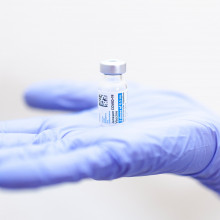
13:01 - Revisiting whether COVID jabs affect periods
Revisiting whether COVID jabs affect periods
Viki Male, Imperial College London
Covid jabs do affect women’s periods, but only to a minor degree and only temporarily and with no long-term impact; that’s the conclusion of a number of studies that were set up last year to investigate reports from some women of menstrual changes in the immediate wake of receiving covid vaccines. We reported last year that this investigation was underway, so it’s a pleasure to circle back and speak again with Imperial College’s Viki Male, who works on the interactions between the immune and reproductive systems. She explained what was going to happen. Now she’s here to tell Chris Smith what’s been found…
Vicki - As the vaccines were rolled out last year, particularly as they were rolled out to younger age groups, people started talking about noticing changes to their periods after they'd had the vaccine and quite a few reports about 35,000 by last autumn had been made to our vaccine safety monitor scheme, the yellow card, and the same sort of thing was happening in the United States of America as a result of which the national institutes of health put aside, um, 1.6, 7 million to do more research into this, to find out if there was a real link. And, um, some of those studies have now started to report,
Chris - How did they investigate?
Vicki - One of the NIH funded studies that reported just a couple of weeks ago, used data that people were inputting into a menstrual cycle tracking app. So this is really nice, because people are inputting their data in real time and also, these people were using the app to help track and control their fertility. So they were really motivated to put in correct data because it would have a real impact on them. There were about 4,000 people in this study of whom 2,400 were vaccinated and the rest acted as unvaccinated controls. After the first dose, they saw no effect on the subsequent period, but after the second dose, there was on average about half a day delay to the subsequent period. So a change, but a small one, and definitely very small compared to natural variation. But the people who really noticed something were those who had both doses in the same cycle. And of course this is something that doesn't happen in the UK because our inter-dose interval, but they had more than a two day delay on their next period. But it's really important to know that even these people who had a two-day delay on the period after they'd had both vaccines in the same cycle, their periods were back to normal within two months.
Chris - What about the other study?
Vicki - So there was another study in Norway, which looked at almost 6,000 people, all of whom had been vaccinated, and they asked them to recall their periods before and after the vaccine. They did notice that about seven and a half percent of people in an unvaccinated cycle would call their period heavier than usual. But about 13.5 percent of people in a vaccinated cycle would call their period heavier than usual. And that was a significant difference. So again, here we have, a change, which in this case is heavier than normal periods, but it's reasonably small compared to normal variation.
Chris - I suppose one very important comparison would be to say, well, what happened if a person in that sit duration actually caught COVID. What does that do to your menstrual cycle?
Vicki - Yes. I think this is also a really important point. So studies that have looked at how COVID affects the menstrual cycle haven't been designed in the same way as these, so we can't compare them exactly. But there have been two, which find that change in menstrual cycles after COVID is between 15 and 25% of people whodone caught COVID. So actually that's quite a large possibility that you'll experience a change if you get COVID.
Chris - Why do we think this is happening and should a person be worried about this?
Vicki - So neither of these studies have really done anything to address the potential mechanism, although as an immunologist, I do think it's quite interesting that you don't see anything after the first dose, but you do after the second dose. When something happens more the second time than the first time, that's so often a sign that the immune system is involved, which of course probably shouldn't be surprising here. Vaccines are designed to work with the immune system. So to me, that suggests that this is an immune mediated mechanism, and we do know that the immune system can crosstalk with sex hormones. And of course it's sex hormones that are driving the menstrual cycle. So that could be one way that this is happening. Another way that this could be happening is because we know that there's a really rich immune system in the lining of the uterus, which helps to control the buildup and the breakdown of the lining of the uterus. So it's possible that a big stimulation of the immune system could affect what's going on temporarily there too. These, to me, are the most likely hypotheses, but definitely in terms of the take home message, the changes that we are seeing are really small compared to natural variation. They reverse quite quickly. So I wouldn't want this to put anyone off getting their COVID vaccine.
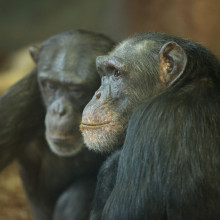
17:51 - Chimpanzees apply insects to their wounds!
Chimpanzees apply insects to their wounds!
Lara Southern, University of Osnabrück & Simone Pika, University of Osnabrück
When you have a nasty cut, or a graze, you naturally go to treat your wound. Now this might include whacking on some antiseptic or applying an analgesic cream and wrapping it up in a plaster. But one family has recently been found using something of an unconventional approach. Harry Lewis heard all about it from Simone Pika and Lara Southern, who are at the University of Osnabrück...
Lara - In this video, you'll see the mother sit up and reach out to grab a small object from under a leaf, which she then moves to her mouth before moving it to the wounded foot of her son. She repeats these last motions a few times, going from her mouth back to the wound of her son, in essence treating him.
Harry - What is Susie reaching out to grab?
Simone - What we know at the moment is that this is a flying insect. We haven't identified the species yet because if you watch closely at what Susie's doing, she's catching it and putting it into her mouth. There are probably two things she's doing here. First of all, she might be immobilising it, so that the insect is not just flying out of her mouth. But it seems she's also pressing it to press something out of it and then put it into the wound. Sometimes they also take it out of the wound again, put it again in the mouth, squeeze it again, and then reapply it. But this means after an insect application event, there's not much left of these tiny little insects and so far, we haven't been able yet to identify this.
Harry - Okay. And we should probably let everyone in on the secret. Shouldn't we Simone, this is actually a group of chimpanzees, isn't it?
Simone - Oh yeah.
Harry - Oh yeah.
Simone - Yeah. Chimpanzees live in a 'fission-fusion system', meaning they are not always together. We have at the moment, in one of our groups, around 45 individuals with adult males, females, and their offspring. But then during the day, the chimpanzees split up into smaller parties. What you see here is a little party, just Susie with her family, but later in the clip, there's another female and a male joining who want to look at what has happened.
Harry - So we think that it's for a medicinal purpose, but have we seen this elsewhere? Is this completely brand new?
Lara - Actually self-medication is quite widespread across a lot of animal taxa. Even in other subspecies of chimpanzees, they do self-medicate with plants by digesting certain plants and leaves. This is to deal with intestinal parasites, but this is the first time that we've ever seen any kind of topical application of any kind of animal matter to a wound specifically.
Harry - I assume that by putting it to the mouth, either disabling it or squashing it, they're releasing the active ingredient.
Simone - We looked into the literature and actually there's huge literature on substances in insects or the larvae. These substances range from antibacterial, antifungal and antiviral to anti-inflammatory and even just soothing substances. We think that there is really the potential that maybe they go for insects, which have these substances. But to really understand this, we first have to identify the insects and then we have to investigate and analyse the involved substances.
Harry - And I'm assuming as well, Simone, that this isn't something that is just a one off. You've seen this happen more than once. Has it spread outside the troope or is it very much within just this family of chimpanzees?
Simone - During the last 15 months, we’ve recorded 76 different wounds and in 25% of these cases, the chimpanzees caught insects and applied them to the wounds. At the moment we think that this is a phenomenon which the majority of our individuals are using. We saw it in 22 different chimpanzees of our 45 chimpanzees.
Harry - From what we’ve already discussed, I know that you don’t know what the insect is, are there any guesses at this stage?
Simone - We can narrow it down to a flying one. Also, maybe you’ve seen this already. When you have a wound, and there is liquid coming out of it, there are a lot of insects that like to land on the wound. If we speculate a little bit about how such a behavior was invented, it could just be possible that it was one of these flies landing on the wound and wanting to get something from the wound. Then the chimpanzee tried to chase it away but smashed it, it landed in the wound and then there was a direct effect that soothed his pain. That could be a possible scenario but we don’t know. Maybe it’s something different and I hope we find out soon.
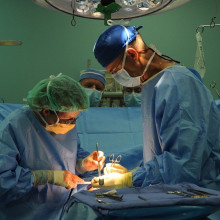
24:53 - A history of transplantation
A history of transplantation
Chris Watson, University of Cambridge
Modern medicine has made transplant surgery much more successful now than it once was. Cambridge University transplant surgeon, Chris Watson, joins Adam Murphy to discuss the history of transplantation starting in the early 20th century...
Adam - Let's take you right back to 1902. Hungarian Emerich Ullmann transplants the kidney of a dog into another dog. He later repeats the process and places the kidney of a goat into a dog - the first record of xeno transplantation; cross-species transplantation.
Chris W - They didn't get very good results from this. One of the problems was the technique of joining blood vessels hadn't really been sorted out. Carrel in France pioneered that.
Adam - 31 years later, Yurii Voronoy from Ukraine took what was learned and carried out the first human transplant. However, having used a cadaver that had been deceased for a few days prior to the procedure, the patient soon ran into complications, which we have learned from since then.
Chris W - Nowadays, when we take organs out, we flush them with an ice-cold preservation solution, then we can keep kidneys for 24-36 hours and get good results. We can keep livers for 12 hours. Hearts are even more sensitive - we can keep hearts for probably four hours.
Adam - Back then, it wasn't really clear where a renal transplant should go.
Chris W - When Ullmann did his goat into dog, he put it into the scruff of the neck of a dog, as there is lot of spare flesh there. He could put a kidney in. Voronoy put it into the thigh of a patient.The benefit of the thigh was the blood vessels are very superficial and you can watch how much urine it produces, because you can bring the urine to the tube that drains urine from the kidney out onto the surface of the leg, and you can watch the urine drip down. Of course, that's not a very long-lasting solution because you get infection going back up into the kidney.
Adam - Yurii's patient only survived two days and it wouldn't be until the early 1950s when Rene Kuss, Charles Dubost and Marceau Servelle carried out a series of renal transplants that some components of the procedure we know today would begin to fall into place.
Chris W - At that time, the French were using kidneys from donors that had been guillotined, and these were criminals who had been sentenced to death and then their kidneys were removed. Having got fresh kidneys and implanted them, they still had a problem that the kidneys didn't work. They worked for a few hours and then they failed. What they hadn't appreciated was this process that we call rejection. This is something that had been identified as a possible problem back during the war years by a scientist called Peter Medawar. So rejection was clearly a problem that had to be overcome. But rather overcome it, the next pioneer was a gentleman called Joseph Murray working in Boston in the States and he had some identical twins - one of whom had kidney failure, one of whom was fit and well. Given that they're identical, there was no immunological difference between them, so he was able to take a kidney from one twin and put it into the next twin. That continued until the sixties, where chemical immunosuppression was started to be used, pioneered by a surgeon in my own hospital here, Sir Roy Calne, who's long since retired, but he developed both azathioprine and cyclosporine as immunosuppressants, which is what allowed transplantation to take off and allowed us to do successful livers, hearts, lungs, as well as getting good results from kidneys.
Adam - So success. But then as now, Sir Roy Calne couldn't find enough donors for the number of patients sitting on that waiting list.
Chris W - Currently, we've got around about 6,000 people waiting for an organ of some type in the UK. Four and a half thousand adults are waiting for a kidney. There are 100 children waiting for kidney, 250 waiting for a lung, 300 waiting for a heart, and about 600 waiting for a liver transplant. We do about 4,000 transplants a year. If you're waiting for kidney, then you can wait and be kept reasonably healthy on dialysis. If you are waiting for a liver, or a heart, or a lung, then you don't have long to wait before you become too sick. So there is a significant mortality, a significant rate of dying, in patients while they're waiting. That's about 10% if you're on the liver transplant waiting list, and as high 25% if you're waiting for a lung transplant.
Adam - If you do receive your transplant, your life is still dictated by your new organ.
Chris W - On immunosuppression, you need to take tablets daily for as long as the transplants last or in the case of a heart, lung or liver, for the rest of your life. Those tablets have their own side effects and they also have adverse effects. So being immunosuppressed puts you more at risk of infections and being immunosuppressed also makes you more at risk of certain sorts of cancer, particularly cancers where there may be a viral aetiology.
Adam - As you can imagine for those with vulnerable immune systems, the last two years have caused even more disruption, having to shield consistently from the coronavirus. On top of this, both the number of donors and transplantations carried out have decreased by a third as a result of the pandemic.
Chris W - If you remember, most of the ICU beds were full of patients with COVID. We weren't sure whether COVID would be spread to patients having a transplant - the likelihood is we thought it could be. And therefore, the last thing we want to do is to give a viral infection to someone and then start them on immunosuppression. The other problem was many of these transplants require patients to go into an intensive care unit for a short period afterwards - livers, hearts or lungs do for example - and there were no intensive care unit beds. So of the 23 kidney transplant programs in the UK, 21 closed for a period of time during that first lockdown, when COVID was really severe.
Chris S - Chris Watson and interestingly, before the turn of the century, traffic accidents accounted for the majority of donors. But with improved road safety, these days donors are increasingly middle aged individuals who have died of other common conditions.
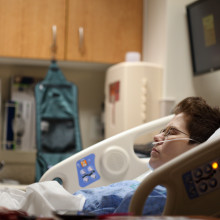
30:51 - Waiting for a transplant
Waiting for a transplant
Joel
Dialysis is a treatment to support people waitlisted for kidney transplants. Adam Murphy and Chris Smith speak with Joel, a person currently on dialysis, on what life is like...
Joel - The particular condition I have is called IGA nephropathy. For many people, it just something that needs to be monitored and never really interrupts their lives. I basically then got unlucky a few years later, much more recently, in that it was causing my kidneys to completely fail. And I guess that was the point for which, for me, was quite hard. There were some tears shed. I guess it's difficult, but at the end of the day, it's just what it is, you have no choice but to face it, you know?
Adam - For those who require it, dialysis like this can take over their life.
Joel - It certainly puts pressure on all aspects of your life. For those of us who are working in particular, you're actually almost robbed of decades of life potentially, because dialysis can't replace the full function of a kidney. And there's all sorts of other complications, like you have weaker bones, so we tend to get fractures more easily, we have dietary restrictions that are real pain.I personally don't have, but I probably will at some point in the future, but many dialysis patients have fluid restrictions.
Chris S - Now in Joel's case, he is currently using what is called peritoneal dialysis, where a cleansing fluid is pumped into the abdominal cavity to soak up the waste material from the bloodstream that the kidneys would normally remove. This is later on drained away and replaced with fresh fluid. Patients usually do this at home, but repeating the process several times a day is very inconvenient and it takes a lot of time.
Joel - That's my mental tray, got my other items - clamps, my caps, and my shields. And I'm also going to need the actual bag of fluid, the lysate. I've been warming this up for the past few hours because it's mid-February and if you put cold fluid into your abdomen, it hurts like hell. So the bag itself - I'll describe it for you - it's basically a bag of fluid attached to a tube and that tube is going to connect to the end of my catheter, which comes out of my abdomen. And I need to drain myself out - and taking with it all of the bad stuff, the urea, and potassium, and various other toxins. This is where we just wait. So I'm nearly completely drained out. I am paying attention because I get something called 'drain pain', which is where if it drains out completely, I get a sharp pain and I can avoid it if I'm really careful and shut it off just before it comes.
Adam - A glimpse there into the laborious and very delicate dialysis Joel has to carry out repetitively whilst on the waiting list.
Joel - I hopefully will at some point in the next year or two receive a kidney transplant from a human, in this case, and that it will be transformative.
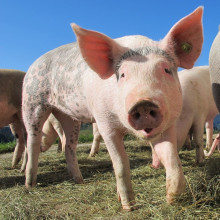
34:57 - Xenotransplants: finding a suitable donor
Xenotransplants: finding a suitable donor
Megan Sykes, Columbia University
Scientists are trying to develop ways to grow replacement human organs in the laboratory, whilst others are developing ways to increase the numbers of donor organs that are fit to be transplanted. But, in the meantime, researchers are turning to animals, particularly pigs, as one way to address the shortfall. Chris Smith and Adam Murphy find out more...
Megan (01:05) - We all have antibodies that recognise pig cells, and those are called natural antibodies. That doesn't exist against other human tissues and cells unless we've had some prior exposure. There are also other parts of the immune system, like the T-cell response, that exist for any foreign tissue or organ that is quite strong against xenographs. And finally, there are what we call innate immune responses from cell types that we call natural killer cells and macrophages that are particularly powerful against xenographs.
Chris (01:48) - So what happens, Megan, if we put just a piece of animal tissue, an animal organ, into a human and we just let the immune system do what it does normally without any kind of drug control or anything.
Megan - Well, if there was no drug control, and say it was a pig organ, and no genetic modifications had been performed, then antibodies in our circulation would immediately bind to the cells lining the blood vessels of that pig organ, and that anti antibody binding would initiate a very dramatic process called hyperacute rejection. Within minutes to hours, those blood vessels would be clotted off and the organ would not have any blood flowing to it and it would die. There were some transplant done initially with non-human primates and these same dramatic antibody effects didn't happen in those combinations. But, of course, there are many problems with using non-human primates as an organ source: some of them are endangered species, there are ethical problems with using them, and there are many infectious risks associated with using non-human primates - so that's pretty much been discounted. The pig, on the other hand, is closer to being the right size, especially if you use miniature pigs which we have in our centre, and they have similar physiology to humans and the risks are actually much more manageable.
Chris - How have you therefore sought to overcome what the immune system naturally wants to do to foreign tissue like that from a pig?
Megan - Our approach really began with the development of nuclear transfer techniques with the famous sheep Dolly back around the turn of the century. In the early 2000s, we and another group were able to use that approach to "knock out" of the pig genome the gene that creates a critical enzyme that creates a critical target that is seen by the vast majority of those natural antibodies that bind to the cells lining the blood vessels. By making this early genetic modification to eliminate this enzyme, we eliminated that target on the endothelial cells of the pig - that was a big step. Our group is working on inducing immune tolerance, not only the ones that are targets of antibodies, but also the targets of T-cells and natural killer cells.
Chris - So, in essence, you are both blinding the immune system to the presence of the new tissue because you have removed from it targets that it would normally regard as hostile, and at the same time you then introduce the new material to the immune system saying, "no, this is friend not foe." How do you persuade the immune system that this is friend not foe?
Megan - Well, we have two methods: one involves removing, from the recipient, the organ that produces T lymphocytes - that organ is called the thymus - and putting in the thymus from the pig. So, in that pig thymus, the T lymphocytes learn that the pig, as well as the human recipient, are both self.
Chris - Can I throw a spanner in the works and say, if you're putting pig tissue in, even if it's a thymus, how do you stop the thymus being rejected before it persuades the immune system it's all right,
Megan - Good question. You have to eliminate the T lymphocytes that are already there in the body so that you're starting with a clean slate.
Chris - I'm with you. And what was the second step.
Megan - With the second approach, we can actually educate the B-cells as well as the T-cells to think that anything on that pig is self so that these lesser targets of antibodies are no longer targeted because the B-cells that see those targets get tolerized as well.
Chris - Obviously the long term goal is we grow new organs for people tailor-made to them, or at least compatible with them, and we don't need to dip into animal reservoirs to solve our problem. But, in the near term, do you think that this has legs, this approach? Using very physiologically similar animals like pigs?
Megan - I do - I think it has legs. I think that bioengineering is making great progress and stem cell biology is making great progress, but the complexity of making a functioning organ from scaffold and cells has not yet been surmounted. It's going to work one day, but that day is quite far off. By that time we may have worked out tolerance to pig organs so well that that will be routine and that will solve the problem.
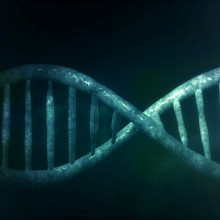
42:23 - Retroviruses concealed in the DNA of pigs
Retroviruses concealed in the DNA of pigs
George Church, Harvard Medical School
We’re going to look at one of the major risks of moving intact animal organs into humans - how we safeguard against infection. Lurking in the animal’s DNA are viruses, which can reawaken in the immunosuppressed patient and begin to infect human cells with unknown consequences. Chris heard from Harvard’s George Church who has found a way to track down the genetic signatures of these viruses and remove them…
George - So, the viruses in the pig genome, these endogenous retroviruses, have been inherited since probably the dawn of mammals, if not earlier. Unfortunately, humans are not resistant to these particular pig viruses - we and others have shown that they will replicate in human cells. Now, whether that is a health risk is not known yet, but I don't feel so lucky that I would want to take a risk that one out of a hundred patients would get sick and possibly spread that virus to their family.
Chris - So, your concern would be: if we were to just put an organ from, say, a pig into a human, including an immunosuppressed human - so they're already fighting with one immune arm tied behind their back - that these viruses lurking in the pig tissue, despite not being human viruses, could nevertheless come out of the pig tissue and begin to infect the human tissue in the new host the organ is in.
George - Exactly. We've shown that these viruses will replicate in human cells. We have not yet shown that they replicate in human beings.
Chris - And how many of these viruses are there lurking inside the pig DNA?
George - They range from about 20 to 80 per genome, and we have established methods that are available to anyone to eliminate all of them. We've shown in peer-reviewed papers that we have eliminated all of them from several strains.
Chris - How do you do that?
George - We use a new method that we helped work in mammalian cells, which is called CRISPR, which is an enzyme that, when introduced into the pig cells, will edit every copy that it is directed to edit. This also works in human cells and is the basis for a variety of therapies. But, in this case, we're engineering the pig germline so that when they breed like regular pigs, from that point on all of their offspring will be virus free.
Chris - In essence, you've got gene editing tools that can go and ferret out where these viruses are in the genome and remove them. Does it remove them entirely, or does it just remove enough of them that they're no longer a threat?
George - We could remove them entirely, but they actually have some positive functions. So, what we do is we remove their ability to replicate, but we don't remove all their genes.
Chris - And is there no danger if you've left the vestige of the virus behind that something could come along and restore the bit you've taken out - so it regains the ability to grow.
George - If something came in from outside, they wouldn't have to restore it - they would already be a risk in and of themselves. But the thing that we've left behind that actually protects them from that outside invasion is a membrane protein, something that coats the pig cells, and prevents them from getting infected by other retroviruses of this category.
Chris - And there's no danger through doing the gene editing that you introduce changes that you don't foresee or plan for so you've solved one problem, but potentially left another booby trap lurking in there.
George - There is that possibility. And that's why it's nice that we're doing it in pigs before we do humans: we get to observe the pigs growing up and breeding and show that generation after generation everything's fine and only then do we transplant them into humans.
Chris - And where's this going to go next? You're in a position where you have created these pigs and they lack what could be regarded as an infectious threat were we to use their organs - are they a kind of foundation now where we can make further changes or tweaks or build on that foundation to use these as the starting stock of animals that could be donors for organ transplants?
George - Yes. We have published on pig strains that have up to 42 changes in their genome, which have all the immunological tricks that Megan told you about earlier: coagulation, they have antiviral strategies all in place, and they've been tested for hundreds of days in primates (which is much longer than any of the human trials so far), and they will be transitioning to human clinical trials very soon. So, there's no barrier to anybody doing similar things in their favourite strain of pig.
Chris - Are you optimistic?
George - Yeah, I'm very optimistic. It's not only going to help us with the organ transplant deficit thanks to the lack of adequate donors, but it will actually give us organs that are enhanced slightly relative to human organs, in that they will be resistant to certain human diseases and possibly, eventually, engineered to be cancer resistant as well.
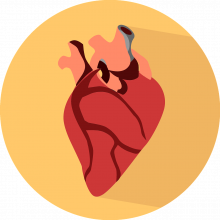
47:33 - The man with a pig's heart
The man with a pig's heart
Muhammad Mohiuddin, University of Maryland
Doctors at the University of Maryland Medical School saw in the new year in style just over a month ago, when they pulled off a world first: the trasnplantation of a pig's heart into a man. Dr Mohiuddin, director of the university's cardiac transplant program, spoke to Chris Smith...
Chris - How's the patient doing, Muhammad?
Muhammad - The patient is doing reasonably well. The progress is slow, but it's according to the plan. The transplanted heart is doing excellent; it's not showing any signs of rejection. We did a biopsy yesterday and it came out very clean, which means that there are no signs of rejection.
Chris - Backtracking slightly, tell us a bit about this patient and why he ended up in the situation where he needed a pig heart.
Muhammad - This patient was admitted to our hospital two months before the transplantation. His heart has gone through failure and our heart failure team determined that he was not a candidate for a human transplant, mostly because of his noncompliance: he has not taken good care of himself and has never taken medicine or gone to the doctor. And, for the last two months, he was also on a machine, the ECMO machine, that serves as an artificial heart. So, this patient was denied of a heart transplant from a human, not only from our institution, but from several other institutions.
Chris - And, for that reason, he was willing to accept the risk that would've gone along with having a pig transplant. How was that even broached? Presumably he didn't bring this up. Did someone on your team say, "Well, look, we are working on this. Would you like to try it?"
Muhammad - Yes. He has shown motivation to live. He always asked if he could get a human heart. We offered to him, "We are doing an experimental procedure where, in our baboon models, we have shown good results of a pig heart with 10 genes surviving for a long period of time. We would like to test it in you if you allow?" And he agreed to it.
Chris - When you do the procedure, is it very similar to the way we currently do human heart transplants where we recover the organ from the donor, it's then rapidly brought to where the recipient is, and then just literally plumbed in: you take the old one out and put the new one in.
Muhammad - The procedure is exactly the same. If you didn't know what was underneath the drapes you would think that there was another human donating the heart. But, in this case, there was a little bit of a difference: the heart that was taken out from the pig was put into this perfusion machine, where it was perfused with a special fluid while taking it to the human where it was put in. There was some disparity between the heart sizes, but that was adjusted by the expert team of surgeons we have.
Chris - Is the heart the right size? Because in my experience having done this sort of work myself in the past, it's very important to get a heart that's not too big or not too small for the size of the patient because otherwise you're asking too much of it or basically trying to cram something that's too big into something that's not designed to fit it. How do you overcome that?
Muhammad - Since this patient had this condition which causes the heart to dilate - when we opened his chest, his heart was found to be a little bigger than the pig heart - the surgeons that performed the surgery, including my partner, Bartley Griffith, were able to adjust that difference and the heart worked perfectly.
Chris - And how are you keeping the patient well? How are you controlling the immune response? Because the heart you've used, and we've heard from Megan and George about how it's been manipulated to make sure it's friendly to the immune system and doesn't pose an infection risk, but obviously there's the patient's own immune system to contend with. How do you make sure that the heart isn't attacked by the patient's immune?
Muhammad - We are using immunosuppression, but to a very minimal amount. My work has targeted a pathway that prevents the crosstalk between the B-cells and T-cells and, as Megan described, both are very important components in attacking the graft. So, with this antibody that blocks that crosstalk, we have been able to get good results in our nonhuman primate model, and it's translating very well in this patient also.
Chris - It was more than a month ago, now, and the person is still doing okay. You must be very buoyed up by this?
Muhammad - Of course. I mean, this is like a dream come true.
Chris - If you can do hearts, does this mean then that pretty much any organ in that pig could be transplanted; the kidneys, the liver, other things that we really struggle to provide for patients?
Muhammad - Of course. That's why we use the 10 gene pig. Another group in Alabama and New York will be using kidneys from similar pigs and trying to do a kidney transplant. The same pig can be used for liver and other organ transplants. One pig for all organs.
Chris - Muhammad, thank you very much, and we wish you luck with the rest of the research. That Muhammad Mohiuddin. Isn't that an amazing outcome? And I hope we have brought you full circle here, listening to this programme this week, where we've started with transplantation over a hundred years ago, to the situation where we are now able to move organs from other animals into humans and they don't get rejected. It's incredible.

QotW: Why don't plants freeze to death?
The answer to this was coming up cold until James Tytko found Proffessor Howard Griffiths from the University of Cambridge...
Howard- Plants from cooler climates have a number of mechanisms which allow them to get used to lower temperatures- as winter approaches, their metabolism adjusts- and plants become ‘hardened’ to the cooler conditions during autumn.
James - And how do they do it?
Howard - To avoid chilling damage, plants change the composition of cell membranes and incorporate shorter unsaturated fatty acids - exactly the ones that are good for us! These changes prevent the membranes becoming more solid, or gel like, under chilling temperatures, and help to maintain normal metabolism.
James - So, eating your greens is even more beneficial in winter due to the plants’ anti-chill techniques. A silver lining to those endless grey clouds, I suppose. But what about freezing?
Howard - In order to avoid damage from ice crystals during freezing, many of our plants shed their leaves in winter- becoming ‘deciduous’.
For the plants which keep their leaves, they can tolerate freezing temperatures by “supercooling”, which can protect plants down to about -12oC. This prevents what’s known as nucleation: the first step in ice formation.
James - Supercooling, nucleation. You’d be forgiven for thinking these were processes going on in some sprawling thermal power plant - but this is all going on inside the most ordinary plants we encounter every day, as Howard explains:
Howard - It’s essentially the same thing as when we add antifreeze chemicals to our car radiators, and salt to de-ice roads: these solutes help to lower the temperature at which water freezes. Plants also accumulate extra solutes in their tissues, and can also make specific antifreeze proteins or ‘cryoprotectants’ which prevent ice formation and help to lower the freezing point of cell tissues.
James - That’s why you shouldn’t walk over a lawn while the grass is still white with frost. The grass underfoot may be supercooled, with your clumsy steps disrupting this delicate process, causing ice crystals to form and putting an end to the poor grass’ resistance.
Howard - Other plants like conifers, which survive extreme temperatures in Siberia and northern Canada, have thickened cell walls and repackage proteins and pigments to prevent damage, and can also tolerate deep supercooling down to -40oC.
James- As seen on TV. David Attenborough covered the boreal forest at the start of episode 3 of The Green Planet if you’d like to see these amazing trees for yourself.
Howard - These processes can have added benefits for us humans as well. Maple syrup, for example, is made from sugar solutions which maple trees use to repair and refill their water transport cells (or ‘xylem’) after surviving a long, cold winter.
James - The sweet taste of victory.
Well, Krzysztof, I hope that answers your question. Plants have a few ways to beat the chill, from changing the makeup of their membranes by incorporating shorter, unsaturated fatty acids, to lowering the temperature at which water freezes within them via additional solutes. It’s all rather remarkable, isn’t it?










Comments
Add a comment